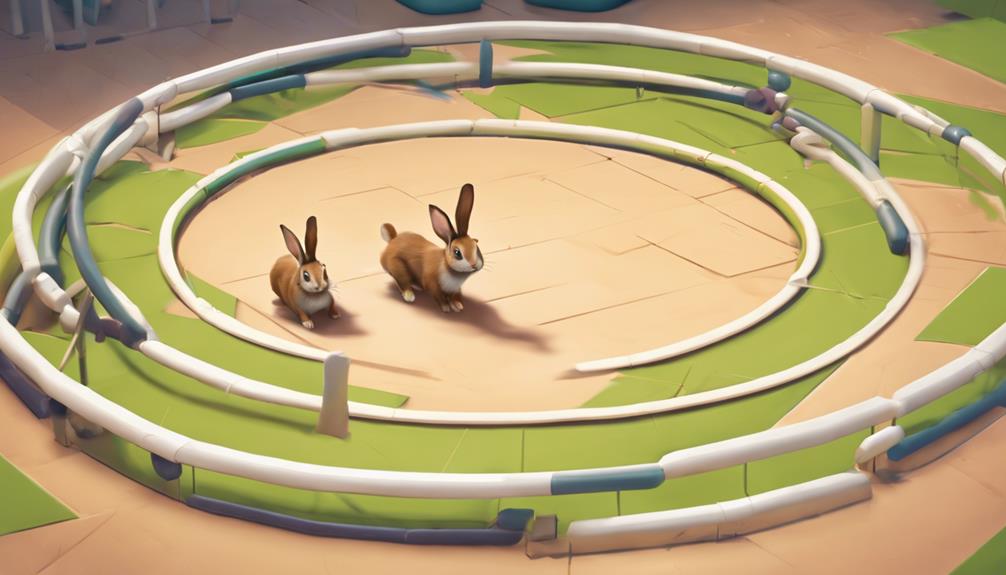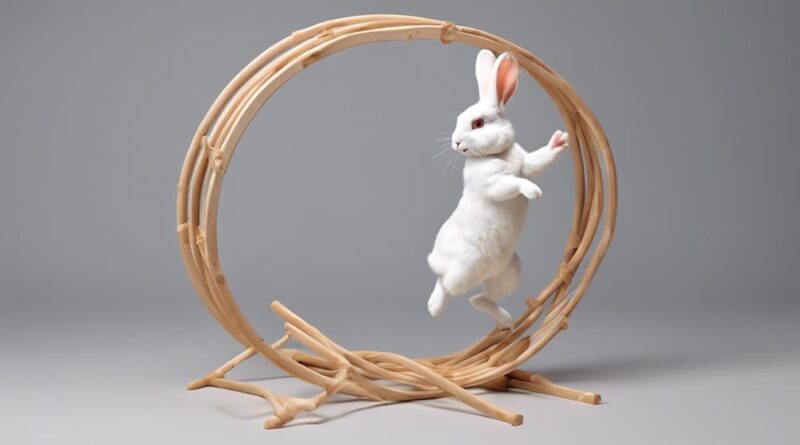Why Are These Rabbit Training Techniques Top-Rated?
Picture a harmonious scene where your rabbit responds eagerly to your commands, displaying impressive skills and obedience.
These top-rated rabbit training techniques have garnered acclaim for their effectiveness and ability to transform the way you interact with your furry companion.
But what sets them apart from the rest? Stay tuned to uncover the secrets behind their success and how they can revolutionize your bond with your beloved bunny.
Understanding Rabbit Behavior
To effectively train your rabbit, understanding their behavior patterns is essential. By observing your rabbit closely, you can pick up on various behavioral cues that indicate their mood and receptiveness to training. Look out for signs like thumping, teeth grinding, or ear positioning, as these can give you insights into how your rabbit is feeling. Positive reinforcement is key in training, so be sure to use training rewards like small treats or verbal praise to encourage desired behaviors.
Communication signals play a crucial role in interacting with your rabbit. They may use body language, such as hopping around or standing on their hind legs, to convey their feelings or needs. Pay attention to these signals to better understand what your rabbit is trying to communicate. Through consistent training and positive reinforcement, you can effectively modify your rabbit's behavior over time.
Behavior modification is a gradual process that requires patience and consistency. When training your rabbit, focus on one behavior at a time and set achievable goals. Whether you're teaching them to use a litter box or to respond to their name, break down the training into small steps to make it easier for your rabbit to learn. Remember to always reward good behavior promptly to reinforce positive habits. By understanding your rabbit's behavior and using effective training techniques, you can build a strong bond with your furry friend.
Setting Up a Training Environment
Understanding your rabbit's behavior is the first step in creating an optimal training environment. When setting up a training space for your rabbit, consistency is key. Choose a quiet area in your home where you can work with your bunny regularly. This helps your rabbit feel secure and comfortable, making it easier for them to focus on the training sessions.
Creating consistency in the training environment involves maintaining a routine. Set specific times each day for training sessions so your rabbit knows what to expect. Consistent training times help establish a pattern that your bunny will recognize and respond to positively. Additionally, using the same training cues and gestures consistently will help your rabbit understand what's expected of them.
Eliminating distractions is another crucial aspect of setting up a productive training environment. Keep the training area free from loud noises, other pets, or anything else that might divert your rabbit's attention. By reducing distractions, you create a focused environment where your rabbit can concentrate on learning new behaviors.
Positive Reinforcement Techniques
When training your rabbit, utilizing positive reinforcement is a highly effective method to encourage desired behaviors. Positive reinforcement focuses on rewarding your rabbit for displaying the behaviors you want to see more of, making it a gentle and efficient way to train them.
Here are three key points to keep in mind when implementing positive reinforcement techniques:
- Consistency is Key: Consistently rewarding your rabbit for good behaviors helps reinforce those actions. Make sure to reward your rabbit immediately after they exhibit the desired behavior to strengthen the association between the action and the reward.
- Use High-Value Treats: Choose treats that your rabbit finds especially enticing as rewards for their good behavior. High-value treats can be a strong motivator and help maintain your rabbit's interest and engagement during training sessions.
- Keep Training Sessions Short and Positive: Rabbits have short attention spans, so keeping training sessions brief and positive is crucial. End each session on a good note to leave your rabbit feeling successful and eager for the next session.
Clicker Training Basics
Consistently rewarding your rabbit for good behaviors helps reinforce those actions, and now, let's introduce the basics of clicker training. Clicker training benefits both you and your rabbit by providing a clear and distinct sound that marks the moment your rabbit performs the desired behavior. This helps your rabbit understand exactly what they're being rewarded for, making the training process more efficient and effective.
One of the key benefits of clicker training is its precision. The clicker sound is consistent and unique, instantly letting your rabbit know when they've done something right. This clarity helps speed up the learning process, as your rabbit can quickly associate the click with the reward they're about to receive.
When it comes to training frequency recommendations, short and frequent sessions work best for rabbits. Aim for multiple 5-10 minute sessions throughout the day rather than one long session. This approach keeps your rabbit engaged and prevents them from getting bored or overwhelmed. Consistency is key in clicker training, so try to incorporate it into your daily routine to maintain progress and reinforce positive behaviors effectively.
Bonding Through Training Sessions
Building a strong bond with your rabbit is enhanced through regular training sessions. These bonding activities not only help strengthen your relationship but also provide numerous training benefits. Here are some ways training sessions can help you connect with your furry friend:
- Quality Time Together: Spending dedicated time with your rabbit during training sessions allows you to bond on a deeper level. Your rabbit will learn to trust and rely on you, strengthening your bond over time.
- Communication Enhancement: Training sessions provide an excellent opportunity to improve communication between you and your rabbit. As you both learn to understand each other's cues and signals, your bond will grow stronger.
- Mutual Understanding: Through training activities, you and your rabbit develop a mutual understanding of each other's needs and preferences. This shared understanding fosters a closer bond and enhances your relationship.
Addressing Common Training Challenges
Tackling common training challenges with your rabbit requires patience and understanding to ensure progress and success in your sessions. One of the common misconceptions when training rabbits is that they aren't as intelligent as other animals, leading to frustration when progress is slow. However, rabbits are smart creatures that respond well to positive reinforcement and consistency.
Effective communication is key in overcoming training challenges with your rabbit. Rabbits rely heavily on body language, tone of voice, and gestures to understand your expectations. Ensuring that your body language is calm and assertive can help your rabbit feel more at ease during training sessions. Additionally, using clear verbal cues consistently can aid in reinforcing desired behaviors.
Another common challenge is impatience during training sessions. It's essential to remember that each rabbit learns at its own pace, and rushing the process can lead to setbacks. Take breaks when needed, and always end on a positive note to keep your rabbit engaged and motivated.
Advanced Training Exercises

To further challenge your rabbit's intelligence and skills, consider incorporating advanced training exercises that build upon the basics covered in earlier sessions. These exercises not only provide mental stimulation but also strengthen the bond between you and your furry friend.
Here are some advanced training techniques to take your rabbit's abilities to the next level:
- Target Training: Utilize target training by teaching your rabbit to touch a specific object, like a stick or a ball, with their nose or paw. This exercise enhances focus and can be the foundation for more complex tricks.
- Agility Courses: Set up mini agility courses with hurdles, tunnels, and ramps for your rabbit to navigate. This activity promotes physical exercise, coordination, and mental agility. Start with simple obstacles and gradually increase the difficulty level as your rabbit progresses.
- Obstacle Courses with Commands: Create obstacle courses that require your rabbit to follow specific commands while maneuvering through them. For example, teach your rabbit to jump over a hurdle on cue or to stop at a certain point. This exercise enhances obedience and responsiveness to your instructions.
Incorporating these advanced training exercises into your rabbit's routine won't only provide enriching experiences but also showcase the intelligence and capabilities of these wonderful animals.
Monitoring Progress and Adjusting Techniques
Consider regularly assessing your rabbit's performance and adapting training methods as needed to ensure continued progress and success. Evaluating the effectiveness of your training techniques is crucial for your rabbit's development. Keep track of your rabbit's responses to different methods and be observant of any signs of progress or stagnation. If you notice that a particular approach isn't yielding the desired results, be ready to adapt your strategies.
Tracking improvements is key to refining your training methods. Take note of what works well and what doesn't, making adjustments accordingly. For example, if your rabbit responds positively to a specific reward system, continue using it to reinforce good behavior. On the other hand, if a certain training exercise seems to confuse or frustrate your rabbit, consider modifying it or trying a different approach altogether.
Frequently Asked Questions
Can Rabbits Be Trained to Do Tricks Like Dogs or Other Animals?
Yes, rabbits can be trained to do tricks like dogs or other animals. By using bonding techniques and clicker training, you can establish a strong connection with your rabbit.
Positive reinforcement and agility training are effective methods to teach rabbits tricks and behaviors.
With patience and consistency, your rabbit can learn various tricks and skills, making training an enjoyable and rewarding experience for both of you.
Is It Possible to Train a Rabbit to Use a Litter Box?
Training a rabbit to use a litter box can be effective through behavior modification techniques. Start by placing the litter box in a spot your rabbit frequents.
When your rabbit uses the box, reward them with treats and praise. If accidents occur, clean the area thoroughly and be patient.
Consistency and positive reinforcement are key to successfully training your rabbit to use a litter box.
How Long Does It Typically Take to See Progress in a Rabbit's Training?
When training your rabbit, progress can vary based on the individual rabbit and the training consistency. Positive reinforcement and behavior modification techniques are key.
With a time commitment and patience, you may start to see improvements in your rabbit's training in a few weeks. Consistent practice and rewarding good behavior are essential for successful training.
Keep at it, and you'll likely notice positive changes over time.
Can Older Rabbits Be Trained as Effectively as Younger Rabbits?
When training older rabbits, remember that behavior modification is still possible. While younger rabbits may catch on quicker, older rabbits can be trained effectively with patience and consistency.
Adapt training techniques to suit their age and pace. Consider any limitations or health issues they may have. The age factor shouldn't discourage you; with the right approach, older rabbits can also learn new behaviors and tricks successfully.
Are There Any Specific Breeds of Rabbits That Are Easier to Train Than Others?
When it comes to training rabbits, breed differences can play a role in training success. Some breeds may be easier to train than others due to their behavioral differences. By understanding these variations, you can tailor your training techniques to suit the specific needs of your rabbit's breed.
Patience, consistency, and positive reinforcement are key regardless of the breed, but being aware of breed tendencies can help you achieve better results in your training efforts.
Conclusion
In conclusion, these top-rated rabbit training techniques are effective because they focus on:
- Understanding rabbit behavior
- Creating a positive training environment
- Using positive reinforcement
- Building a strong bond through training sessions.
By incorporating clicker training basics, addressing common challenges, and progressing to advanced exercises, you can effectively train your rabbit while monitoring their progress and adjusting techniques as needed.
Happy training!
